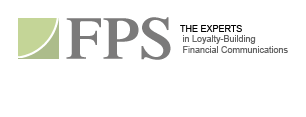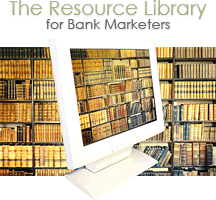 |
 |
| OCTOBER 2007 |  |
What we do |  |
Work Samples |  |
FPS Resource Library |
|
Bank Marketers Embracing Customer-Driven Innovation By Vince DiPaolo & Christine Durkin In a 2006 BusinessWeek survey, 70% of respondents cited innovation as one their company's top three strategic priorities. Until recent years, innovation was typically embodied in the development of new products. Today, however, no matter how innovative you may think your product is, you can bet that it will soon become commoditized. Today, we view innovators as those who creatively apply products to enhance the customer experience. With this new definition in mind, in this edition of MarketScope we look at some of the innovative technologies that are helping financial institutions to achieve customer innovation. Improving existing technologies Web-site design E-mail marketing New technologies
In its 2006 white paper Organic Customer Growth for Financial Services Institutions, SAS described its vision for a new enterprise-wide, integrated intelligence technology platform. SAS is one of a number of companies dedicated to developing technology that assists financial institutions in achieving a "single view of the customer," a view that transcends longstanding information silos still in place at most financial institutions. SAS' services include centralizing customer data, developing customer profiles for predictive buying analysis, price bundling, identifying and engaging high potential customers and prospects, and finally, creating banking-specific customer retention models that also support segmentation and cross-sell/up-sell models. Similarly, Eloqua has developed a system that integrates information for more in-depth customer insights. According to Eloqua, when you reach prospects and clients through multiple media and with multiple frequencies over time, your messages are reinforced and recipient responses tend to be stronger. Accordingly, marketers are likely to have far better results if they can reach their prospect with a combination of an e-mail, a phone call and a direct-mail contact than if they used only one of those channels multiple times. To facilitate this multi channel approach, more banks are using integrated demand generation platforms. These platforms enable banks to plan, execute and then measure the effectiveness of their multi-channel campaigns. Demand generation applications integrate and synchronize a whole spectrum of offline and online marketing channels, which include e-mail, direct mail, advertising, the Web, call centers, and trade shows. These also include contacts by both bank sales representatives and business affiliates (for example, technology providers who offer their services through a bank). With these types of multi-faceted solutions, bank marketers are doing more than communicating with prospects. They also are closely monitoring and reacting to the implicit buying signals in each prospect's response to marketing messages. Signals that prospects send include visits to bank Web site pages containing information about specific issues, products and services. Prospects also send signals when they register for bank-sponsored events or download white papers or other content from your bank's Web site. All these signals provide intelligence your sales representatives can use to provide more relevant follow-up with prospects and thus accelerate the sales cycle. . . . Financial Publishing Services Co. If you are not already a MarketScope subscriber, please request your own free monthly edition. |

 Subscribe to MarketScope RSS Feeds
Subscribe to MarketScope RSS Feeds